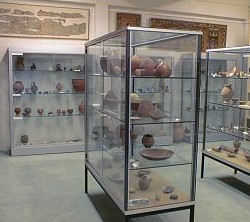
Geschichte des Institutes für Papyrologie und Ägyptologie der Universität Charles de Gaulle Lille-3 und seiner Sammlung
Der Gründer des Institutes für Ägyptologie: Pierre Jouguet
P. Jouguet war Dozent an der Universität Lille und zukünftiger Direktor des Französischen Archäologischen Institutes in Kairo (IFAO). 1902 schlug er die Gründung eines Institutes vor, das die Funde aus den Grabungen beherbergen sollte, die er seit 1901 in Mittelägypten und im Fajjum in Medinet Ghôran und in Medinet en-Nehas, dem alten Magdola, durchgeführt hatte. Das Institut wurde Ende 1902 von der Philosophischen Fakultät und dem Rat der Universität Lille offiziell gegründet. Es wurde im Januar 1903 von dem berühmten Archäologen Théophile Homolle, dem früheren Direktor der École d'Athènes und Vertreter der Académie des Inscriptions et Belles Lettres, feierlich eröffnet.
Jouguets Absicht war es, die Teilnahme Frankreichs und der Universität Lille an der Suche nach griechischen Papyri zu verstärken, die zu jener Zeit in Ägypten einen Höhepunkt erreichte und an der sich alle großen Nationen beteiligten. Dieses Ziel wurde erfolgreich erreicht, wie die schiere Menge von griechischen und demotischen Papyri beweist, die zwischen 1901 und 1903 entdeckt und zwischen 1921 und 1928 vom Institut für Papyrologie publiziert wurden.
P. Jouguet brachte nicht nur Papyri zurück ins Institut, sondern auch die Objekte, die auf der Suche nach den Texten gefunden worden waren. Diese Objekte stammen aus den verschiedensten Zeiten. Die Sammlung wurde so um einen prädynastischen ägyptischen Krug, eine Schieferpalette von herausragender Qualität, ein seltenes Fragment eines magischen Elfenbeinobjektes aus dem Mittleren Reich und viele Objekte aus den Griechisch-Römischen Gräbern bereichert, die die kostbaren Mumienkartonagen enthielten, nach denen die Papyrusjäger trachteten. Dieser anhaltende Strom von Funden wurde 1903 unterbrochen, als es nicht mehr möglich war, ganze Fundkomplexe zurückzubringen - die Objekte mußten jetzt in Ägypten bleiben.
Der Impuls, den das Institut von seinem Schöpfer empfangen hatte, ermutigte lokale Talente. Die ersten Studenten waren Paul Collart und Henri Henne, die in Lille Griechische Papyrologie studierten, denen Henri Sottas folgte, der die demotischen Papyri studierte. Diese Blüteperiode wurde vom Ersten Weltkrieg und der Invasion 1914 unterbrochen. Pierre Jouguet ging nach Paris, um nie mehr zurückzukehren, und H. Henne nahm seinen Platz als Leiter des Institutes ein, sobald die Philosophische Fakultät es wiedereröffnen konnte. Seine Politik war eine Fortführung derjenigen von Jouguet, und er ermöglichte es der Universität Lille, an Ausgrabungen im Niltal teilzunehmen, wobei jene in Edfu in Oberägypten von 1921 bis 1924 hervorzuheben sind. 1939 wurden die Ausgrabungen durch den Zweiten Weltkrieg unterbrochen.
Weitere Ergänzungen der Sammlung
Die Französische Archäologische Mission für den Sudan wurde 1953 gegründet. Sie wurde von der 'Direction Générale des Relations Culturelles, Scientifiques et Techniques' des Außenministeriums finanziert und mit dem CNRS (URA 9) assoziiert. 1960 wurde Jean Vercoutter, ein Pionier der archäologischen Forschung im Sudan, mit ihrer Leitung beauftragt. 1961 wurde er zum Professor an der Universität Lille-3 ernannt, und er unternahm die Wiederbelebung der Tradition des Institutes für Papyrologie und Ägyptologie (IPEL), Kontakt mit der archäologischen Felsarbeit zu halten. Er führte auch seine eigenen Forschungen im Sudan weiter.
Jean Vercoutter hauchte dem Institut neues Leben ein. Er lehrte Geschichte, Archäologie und die ägyptische Sprache, er gründete das Journal CRIPEL (Cahiers de Recherche de l'Institut de Papyrologie et d'Egyptologie de l'Université de Lille) und zog neue Generationen von Studenten der Griechischen Papyrologie, Ägyptologie und Sudanologie an, die er in seine großangelegten archäologischen Projekte im Sudan miteinbezog.
Zwischen 1960 und 1964 verlagerte sich seine Aufmerksamkeit von Kor, wo er seit 1953 gearbeitet hatte, auf zwei Plätze, die von der Errichtung des neuen Hochdammes bei Assuan gefährdet waren. Der erste, Akscha, liegt nahe der sudanesischen Grenze zu Ägypten. Unter den ausgegrabenen Strukturen befindet sich ein Tempel Ramses' II., ein meroitischer Friedhof sowie kleinere Friedhöfe der A- und der C-Gruppe.
Mirgissa liegt gegenüber des Zweiten Kataraktes. Es ist ein sehr reichhaltiger Ort, der aus einem Friedhof der Kerma-Zivilisation, einer Stadt mit mehreren Friedhöfen und einem befestigten Bezirk mit einem Hathorschrein in seinem Inneren besteht. Abgesehen von den Objekten, die in diesen unterschiedlichen Kontexten gefunden wurden, ist auch die Entdeckung eines Depots mit Ächtungstexten erwähnenswert.
Die sudanesische Regierung geht mit den Fundteilungsregelungen liberal um, und dank dieser Großzügigkeit haben die beiden letztgenannten Fundorte den Großteil der derzeit in der Sammlung befindlichen Objekte geliefert.
Jean Vercoutter grub auch den Fundplatz Sai aus, der auf einer Insel liegt. In seiner außergewöhnlichen Archäologie ist jede Zivilisation des sudanesischen Niltales vom Paläolithikum bis zum heutigen Tag vertreten.
1977 wurde Jean Vercoutter zum Direktor des IFAO in Kairo ernannt. In Lille folgte ihm Adolphe Gutbub, dem wiederum Professor Dominique Valbelle nachfolgte, die derzeitige Direktorin des IPEL. Sie steht der Forschungsabteilung vor, die dem CNRS an der Universität Lille-3 (URA 1275) angeschlossen ist, die in Ägypten und auf dem Sinai archäologische Untersuchungen vornimmt. Seit mehreren Jahren ist Francis Geus, Dozent und früherer Student und Mitarbeiter von Jean Vercoutter, der in Sai im Sudan ausgrub, ihr Assistent. Brigitte Gratien, die seit 1993 Direktorin des Forschungsprojektes URA 1275 ist, hat seit 1969 in Sai und in Mirgissa gearbeitet. Ihre derzeitigen Ausgrabungen finden an dem sudanesischen Fundplatz Gism el-Arba statt.
Ausgrabungen sind nicht die einzige Art und Weise, eine Sammlung zu bereichern. Dank eines einmaligen Zuschusses der Universität Lille-3 konnte kürzlich eine Anzahl von Papyri angekauft werden. Die Großzügigkeit eines privaten Sponsors ermöglichte es 1976, den Vandier-Papyrus in die Sammlung aufzunehmen. Im selben Jahr wurde von den Städten Lille, Roubaix und Tourcoing eine öffentliche Spendensammlung organisiert, die den Ankauf einer Gruppe demotischer Papyri ermöglichte. Die Regionalversammlung von Nord-Pas de Calais hat ebenfalls zur Sammlung beigetragen, indem sie eine Gruppe von Papyri der Koptischen Zeit stiftete.
Weiterhin muß ein Geschenk der École des Arts Plastiques an das Institut im Jahre 1990 erwähnt werden, das aus einer Gruppe koptischer Textilfragmente besteht. Der einzige Hinweis auf deren Herkunft ist eine handgeschriebene Notiz, die an ihnen befestigt ist: 'Von einem Ausgräber in Unterägypten oder in Mittelägypten am Beginn des 20. Jahrhunderts (?) dem Direktor der École des Beaux-Arts übergeben, der sie der Bibliothek überreicht hat'.